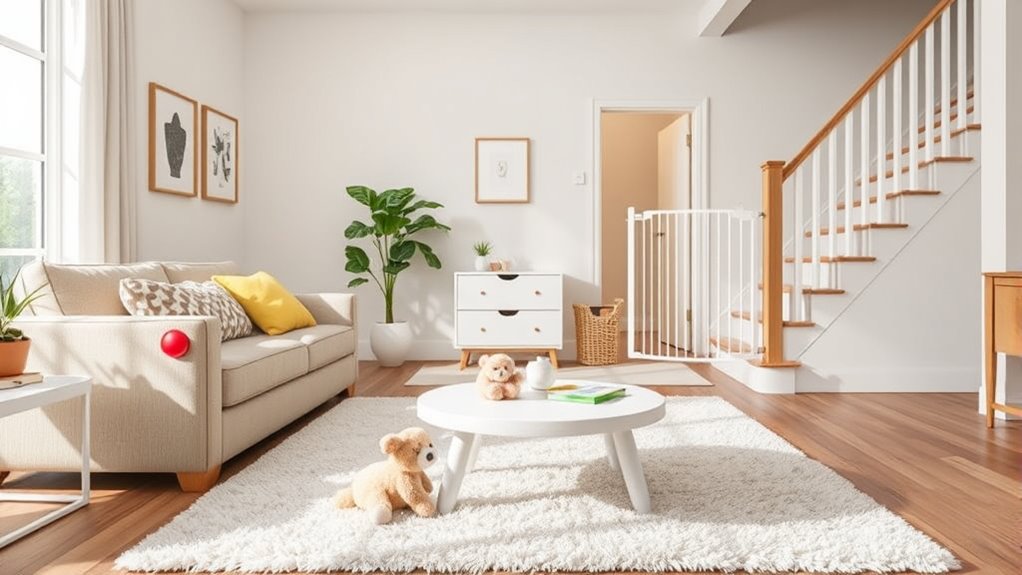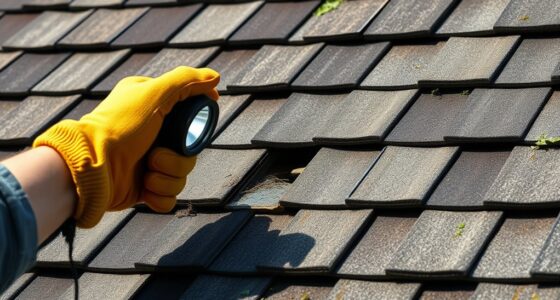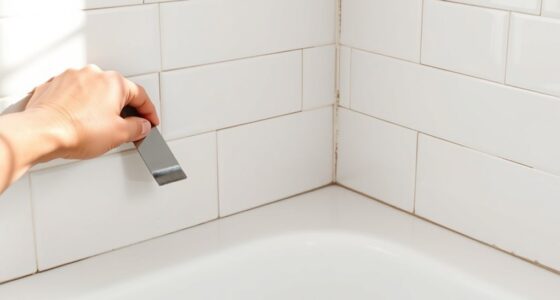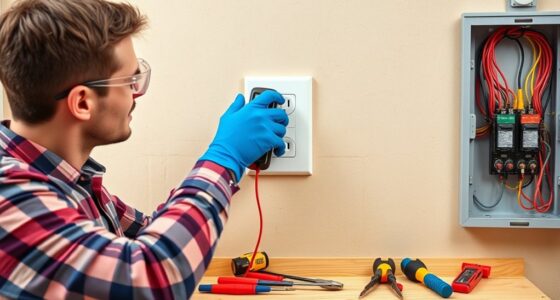To childproof your house, start by inspecting for common hazards like small objects, sharp edges, and accessible chemicals. Install safety devices such as cabinet locks, outlet covers, safety gates, and corner protectors, making certain they’re properly fitted and maintained. Supervise your kids actively and regularly check your setup to guarantee ongoing safety. By following these steps, you’ll create a safer environment where your child can explore with confidence—more tips await to help you childproof effectively.
Key Takeaways
- Install safety devices like outlet covers, cabinet locks, and corner protectors to prevent common household injuries.
- Regularly inspect and maintain safety equipment to ensure proper functionality and ongoing child safety.
- Keep small objects, chemicals, and sharp items out of children’s reach and sight to prevent choking and poisoning.
- Supervise children actively, using technology such as cameras and sensors for added safety.
- Educate caregivers and family members about potential hazards and proper safety practices for a safer home environment.
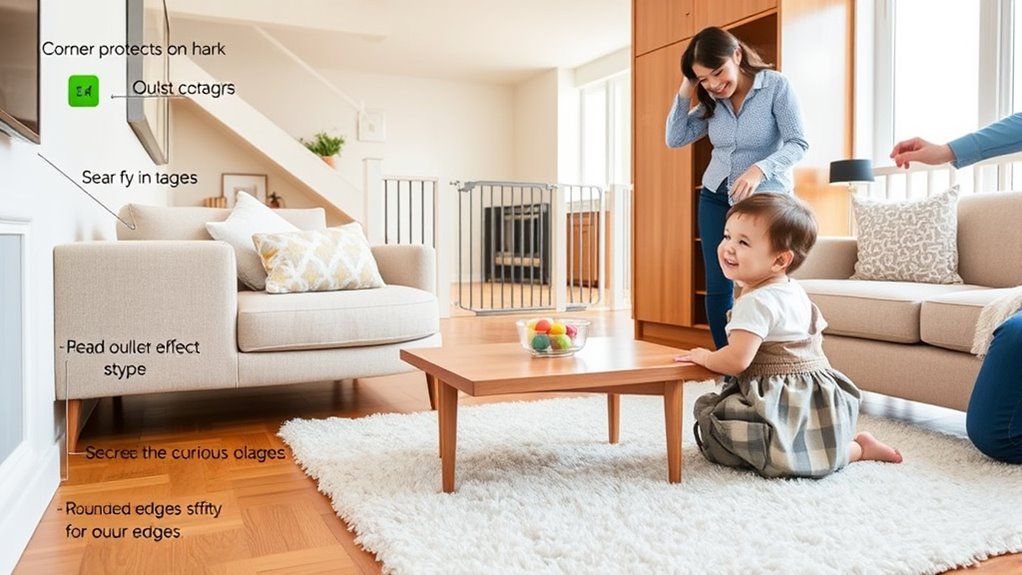
Are you aware of how quickly accidents can happen in your home? Children, especially those under four, are naturally curious and unaware of dangers. Each year, over a thousand young children die from mechanical suffocation and choking, highlighting how essential it is to childproof your house. The good news is that many hazards are preventable with simple, cost-effective safety measures. You don’t need to spend a fortune; many safety devices are inexpensive and easy to install. The key is understanding which hazards to address and ensuring these devices are correctly installed and maintained. Proper installation and regular re-engagement of safety devices are imperative because a safety lock or gate isn’t effective if it’s loose or improperly fitted.
Start by securing cabinets and drawers containing medicines, cleaning supplies, or small objects that could pose choking hazards. Using cabinet locks can prevent children from accessing harmful substances. Outlet covers are another simple but essential tool, preventing electrical injuries from curious little fingers poking into sockets. Safety gates are indispensable for blocking off stairs or other dangerous areas, reducing the risk of falls. Corner protectors can soften sharp furniture edges, helping prevent cuts and bruises when children bump into tables or walls. Door stoppers are useful for avoiding finger injuries caused by doors slamming shut unexpectedly. These devices are affordable and straightforward to install, making a significant difference in your child’s safety.
Secure cabinets, use outlet covers, install safety gates, and add corner protectors for a safer home environment.
Supervision remains a cornerstone of child safety. While safety devices provide a safety net, active watching and continuous monitoring are essential. Regularly inspecting your home for hazards and using technology like cameras or sensors can help you keep an eye on your little ones even when you’re not directly supervising. Educating yourself and other caregivers about common hazards and safety practices can prevent many accidents. Remember, children are quick, and hazards like small objects, chemicals, or sharp furniture edges can cause injuries in seconds. Ensuring your home complies with safety standards and laws, such as those set by the Consumer Product Safety Commission, adds an extra layer of protection. Research indicates that home safety measures significantly reduce the risk of accidents and injuries.
Investing in childproofing isn’t just about peace of mind; it’s about protecting your child’s future. Many safety measures are inexpensive but have long-term benefits by reducing potential medical costs from injuries. Community programs and neighborhood support can also offer resources and shared safety initiatives, strengthening safety efforts for all families. Ultimately, ensuring your home is safe for your child combines proactive safety devices, vigilant supervision, and a well-informed approach. Taking these steps can help create a secure environment where your child can explore and grow without unnecessary risks.
Frequently Asked Questions
When Should I Start Childproofing My Home?
You should start childproofing your home as early as possible, ideally during pregnancy or right after your baby is born. It’s best to complete the initial safety measures before your little one becomes mobile around 4 to 6 months. Early preparation guarantees a safe environment and helps you adapt as your child grows. Remember, childproofing is a continuous process that evolves with your child’s development.
How Can I Childproof Outdoor Areas Effectively?
To childproof outdoor areas effectively, you need to regularly inspect surfaces and equipment, making sure they’re safe and secure. Enclose pools with high fencing and lock gates, and anchor play structures properly. Use safety gates on stairs, secure chemicals, and keep hazards like sharp tools out of reach. Maintain fences, supervise children closely, and teach them about outdoor dangers. Always stay vigilant and keep outdoor spaces tidy to prevent accidents.
Are There Specific Safety Devices for Toddlers Versus Older Children?
Are you wondering if safety devices differ for toddlers and older children? You should know that toddlers need adjustable, padded devices designed to prevent falls and injuries, while older kids benefit from safety harnesses that promote independence. Both groups require devices meeting safety standards, but the focus shifts from protection to guidance. By choosing age-appropriate safety gear and installing it correctly, you keep your children safer and encourage responsible behavior.
How Often Should I Review and Update My Childproofing Measures?
You should review and update your childproofing measures every few months to keep up with your child’s rapid development. Regular safety checks, like monthly or quarterly, are essential, especially after milestones or home changes. As your child becomes more mobile or curious, you’ll need to adapt safety devices, secure new hazards, and reassess risks. Staying proactive ensures your home remains safe as your child’s abilities grow.
What Are Common Household Hazards I Might Overlook?
Imagine a bright room where toys are scattered, but hidden dangers lurk beneath. You might overlook loose cords dangling from curtains, or a seemingly harmless bucket filled with water. Unstable furniture, a hot stove, or an open toilet lid can pose serious risks. These household hazards often go unnoticed until it’s too late, so regularly scan your home to spot and fix these sneaky dangers before your child does.
Conclusion
By childproofing your house, you create a safer space, prevent accidents, and protect your little one. By securing cabinets, covering outlets, and removing hazards, you build a safer environment, foster peace of mind, and promote your child’s independence. Remember, safety is an ongoing process—regularly check, update, and stay vigilant. By taking these steps, you guarantee your home remains a safe haven, a place where your child can explore, learn, and grow with confidence.

